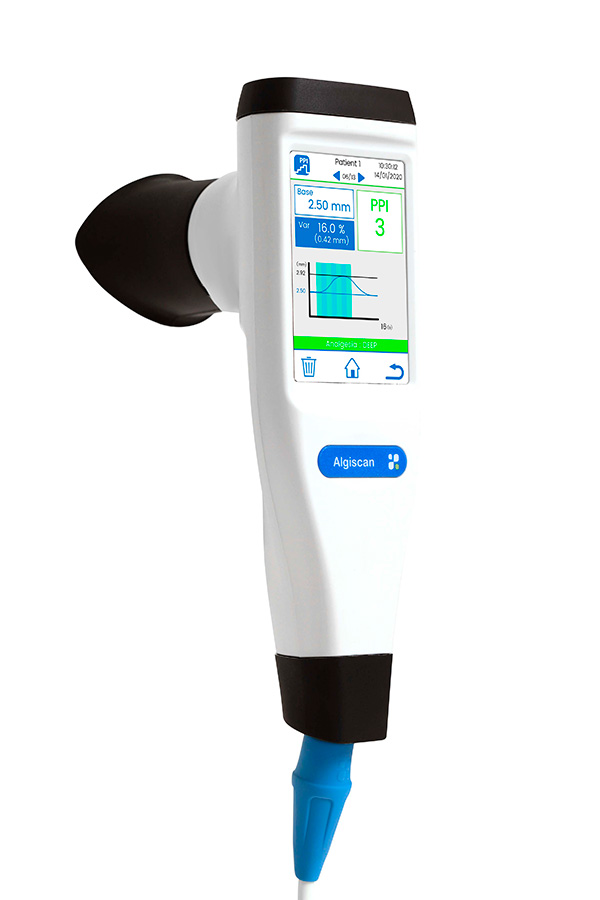Measuring the analgesia level of patients is an obvious requirement for anesthetists specialists.
More information about this product? Feel free to contact us.
AlgiScan Analgesia Monitor
Measuring the analgesia level of patients is an obvious requirement for anesthetists specialists. The Pupillary Reflex Dilation (RPD) has proved its specificity and consistency in measuring the analgesia level of patients, in the operating theatre as well as in intensive care.
Using an exclusive process, the AlgiScan quantifies within seconds the reflex papillary dilatation through an integrated nociceptive stimulator.
Its variable intensity electric stimulations provide practitioners with the possibility of validating and forecast the appropriate analgesia level for all medical and surgery actions.
Its straightforward operation, instantaneous measurements enable you to use it daily, and without any restraints, to validate your analgesia assessments.
The AlgiScan offers a dynamic and bespoke approach of the patient’s analgesia. Various medical teams have demonstrated the advantages of analgesia measurement through pupillometry.
From validating loco-regional anesthetics under general anesthesia to avoiding morphine, and including the measurement of individual reaction of patients to pain, the AlgiScan is the analgesia monitoring clinical tool.
Reaction from a user
“A better knowledge of individual reaction to pain and to morphine effects, as well as a valuation of the actual nociceptive stimuli, allow to maximize, individually and throughout the course of operations or care, the patients’ real opioid requirements.”
References
Reflex pupillary dilatation in response to skin incision and alfentanil in children anaesthetized with sevoflurane: a more sensitive measure of noxious stimulation than the commonly used variables.
Constant I, Nghe MC, Boudet L, Berniere J, Schrayer S, Seeman R, Murat I. Paris Br J Anaesth. 2006
Effect site concentrations of remifentanil and pupil response to noxious stimulation.
Barvais L, Engelman E, Eba JM, Coussaert E, Cantraine F, Kenny GN.Erasme Hospital, Belgium Br J Anaesth. 2003
2010-2011 – Pupillary reflex dilation to assess unilateral popliteal sciatic nerve block during general anesthesia / Contrôle par pupillométrie de l’efficacité de l’analgésie loco-régionale sous anesthésie générale.
S.Isnardon, M. Vinclair, A. Hébrard, P. Incagnoli, B. Oummahan, C. Jacquot, P. Albaladejo, J. F. Payen Pôle Anesthésie-Réanimation, CHU Michalon, Grenoble, France
Pupillary response to noxious stimulation during isoflurane and propofol anesthesia.
Larson MD, Sessler DI, Washington DE, Merrifield BR, Hynson JA,McGuire J.. Anesth Analg 1993;76: 1072–8
Congrès SFAR 2011 – Intérêt de la pupillométrie pour évaluer les besoins en sédation analgésie avant les pansements complexes.
D. Dereu, A.C. Lukaszewicz, A.L. Feral-Pierssens, F. Bart, J. Mateo, D. Payen (C.H.U. Lariboisière Paris)
Congrès SFAR 2011 – Pupillométrie, variabilité du rythme cardiaque et évaluation de la douleur chez l’enfant sous anesthésie générale.
A. Kowalczyk 1,*, V. Chandesris 1, P. Desgranges 1, M. De Queiroz 1, J. C. Cejka 1, D. Chassard 1, O. Rhondali 1 (Hopital H.F.M.E., LYON, France)
Congrès SRLF 2010 – Intérêt de l’examen pupillaire automatisé en réanimation.
E.Hautin, M.Cour, J.Llinger, L.Argaud Réanimation médicale, hopital Edouard Herriot CHU Lyon, (Lyon)
Congrès SFAR 2011 – Évaluation du réflexe de dilatation pupillaire évalué par vidéopupillométrie et des variations de fréquence cardiaque lors de stimulations tétaniques d’intensité croissante chez l’enfant anesthésié par kétamine.
N. Louvet, T. Giral, N. Sabourdin, M.L. Guye, P. Richard, I. Constant (C.H.U. Trousseau Paris)
Congrès SFAR 2011 – La pupillométrie comme mesure d’installation de l’analgésie par ALR périphérique en pédiatrie.
M.A. Girard, E. Giaouin, F. Lacroix (C.H.U. La Timone Marseille)
Congrès SFAR 2011 – Effets de la contraction au cours du travail obstétrical et de l’analgésie péridurale lombaire sur le réflexe photomoteur. Résultats préliminaires.
M. Ghalayini, E. Bedairia, L. Guezouli, B. Wachowska, D. Michel, P. Montravers, D. Longrois, J. Guglielminotti (C.H.U. Bichat Paris)
Congrès SFAR 2011- La pupillométrie peut elle évaluer l’intensité de la nociception lors de différentes incisions chirurgicales?
M. Mazerolles, H. Vinour, F. Leballe (Toulouse)
Congrès SFAR 2011 – Evaluation de l’analgésie postopératoire en SSPI par le pupillomètre.
A. Snauwaert, M. Aissou, C. Dupuis, T. Bagnol, F. Aubrun, M. Beaussier (C.H.U. St Antoine Paris)
Congrès SFAR 2011 – Evaluation de l’utilisation de la pupillométrie dans l’optimisation de l’analgésie lors d’une chirurgie gynécologique majeure.
J. Barrois, C. Dadure, A. Rigouzzo, N. Sabourdin, N. Louvet, I. Constant (C.H.U. Trousseau Paris)




